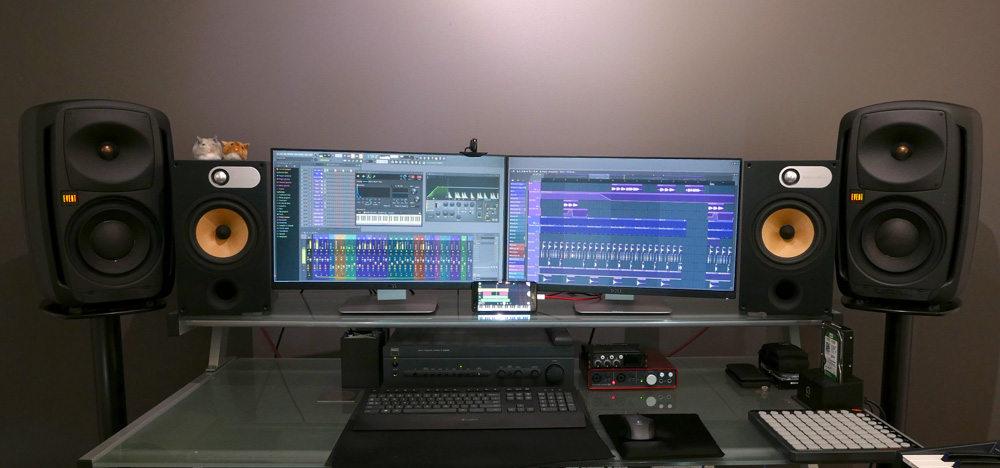FL Studio is a popular music production software. It’s used by many musicians and producers.
Understanding how much space FL Studio requires is essential before installation. This knowledge helps you manage your computer storage better. FL Studio comes in different versions, each with varying storage needs. Whether you’re a beginner or an advanced user, knowing the space requirements can save you from potential issues.
In this blog post, we will explore the space needed for FL Studio. You’ll learn about the minimum and recommended storage for different versions. This information will ensure a smooth setup and optimal performance of your music production software. Stay tuned to find out more about FL Studio’s space requirements.
Introduction To Fl Studio
FL Studio is a popular digital audio workstation (DAW). It is a powerful tool for music production. Many musicians and producers use it worldwide. Let’s explore its history and features.
Brief History
FL Studio started as FruityLoops in 1997. It was created by Didier Dambrin. Over the years, it evolved. In 2003, it was renamed to FL Studio. Image-Line is the company behind it. They constantly update and improve the software.
Key Features
FL Studio offers many features. Here are some key ones:
- Step Sequencer: Easy to use. Helps in creating drum patterns quickly.
- Piano Roll: Allows detailed editing of notes and chords.
- VST Support: Compatible with various plugins. Enhances functionality.
- Mixing and Effects: Includes built-in mixers and effects. Provides professional sound quality.
- Automation: Automate parameters for dynamic changes.
Each feature enhances the music production process. FL Studio is user-friendly. It suits both beginners and professionals.
System Requirements
Understanding the system requirements for FL Studio is crucial. This ensures a smooth music production experience. Let’s explore the minimum and recommended specifications for running FL Studio effectively.
Minimum Specifications
To run FL Studio, your computer needs to meet basic requirements. You need at least a Windows 8.1 or macOS 10.13. Your processor should be an Intel or AMD with a minimum of 2 GHz. At least 4 GB of RAM is necessary. FL Studio requires 4 GB of free disk space. A screen resolution of 1280×800 pixels is essential.
Recommended Specifications
For the best performance, higher specifications are advised. A Windows 10 or macOS 10.14 system is ideal. Your processor should be an Intel Core i5 or AMD equivalent. At least 8 GB of RAM will ensure smooth operation. FL Studio works best with 8 GB of free disk space. A screen resolution of 1920×1080 pixels is recommended.
Installation Size
Understanding the installation size of FL Studio is crucial. It helps to know how much space you need on your device. Below, we break down the installation size into two main parts.
Initial Download Size
The initial download size of FL Studio is around 900 MB. This size includes the basic program files. These are necessary for the software to run. You can download the file from the official website.
Make sure your internet connection is stable. A slow connection can affect the download process. It might take more time than expected.
Post-installation Size
After installation, FL Studio can take up to 2 GB of space on your hard drive. This size includes all the additional files unpacked during the installation. It also includes some default plugins and samples.
Here is a quick table for a better understanding:
| Type | Size |
|---|---|
| Initial Download | 900 MB |
| Post-Installation | 2 GB |
Keep in mind, the size can increase. Installing extra plugins and samples will take more space. Always check your available disk space before installation.

Credit: support.image-line.com
Factors Affecting Size
FL Studio is a popular music production software used by many artists worldwide. The space it occupies on your device depends on several factors. Understanding these factors helps in managing your storage effectively.
Plugins And Add-ons
Plugins and add-ons significantly affect the size of FL Studio. Each plugin adds unique sounds and effects. Some plugins are small, while others can be quite large. Add-ons also include additional instruments and sound packs. These items can quickly add up, increasing the overall size.
Project Files
Project files are another major factor. Every project you create in FL Studio generates a file. These files store all the details of your music project. The more complex your project, the larger the file size. Including many audio tracks and samples will further increase the size.
Managing Disk Space
Managing disk space is essential for FL Studio users. As projects grow, FL Studio demands more space. This can slow your system. Learn how to manage disk space to keep your workflow smooth.
Clearing Cache
FL Studio stores temporary files in the cache. Over time, this cache grows. Regularly clear the cache to free up space.
Follow these steps to clear the cache:
- Open FL Studio.
- Go to Options.
- Click File Settings.
- Find the Cache folder.
- Click Clear to delete temporary files.
Clearing the cache can free up significant disk space. This helps FL Studio run smoothly.
Storing Projects Externally
Projects can take up a lot of space. Store them externally to save disk space on your computer.
You can use:
- External hard drives
- USB flash drives
- Cloud storage services
Storing projects externally has many benefits. It frees up space on your computer. It also keeps your projects safe from hardware failures.
Here is a simple table to compare storage options:
| Storage Option | Capacity | Accessibility |
|---|---|---|
| External Hard Drive | Up to 4TB | High |
| USB Flash Drive | Up to 256GB | Medium |
| Cloud Storage | Unlimited | High |
Choose the best option based on your needs. Regularly move older projects to external storage. This keeps your computer’s disk space free and your FL Studio running efficiently.

Credit: www.nichetampa.com
Optimizing Performance
FL Studio is a powerful tool for music producers. However, it needs the right setup for smooth performance. Optimizing performance in FL Studio can lead to better efficiency and a more enjoyable creation process. This section will focus on two key areas: adjusting settings and upgrading hardware.
Adjusting Settings
Adjusting settings can greatly impact the performance of FL Studio. Here are some tips:
- Buffer Length: Increase buffer length to reduce CPU load.
- Sample Rate: Use a lower sample rate to save CPU.
- Multithreaded Processing: Enable this for better CPU usage.
- Smart Disable: Turn this on to disable unused plugins.
These adjustments can make a significant difference. They help in reducing CPU usage and improving overall performance.
Upgrading Hardware
If adjusting settings is not enough, consider upgrading your hardware. Here are some key components to focus on:
| Component | Recommendation |
|---|---|
| CPU | Choose a multi-core processor. |
| RAM | At least 16 GB is recommended. |
| Storage | Use SSD for faster data access. |
| Audio Interface | Invest in a high-quality audio interface. |
Upgrading these components can help FL Studio run more smoothly. This ensures a better experience for music production.
Comparing With Other Daws
When choosing a Digital Audio Workstation (DAW), space requirements can be a deciding factor. Let’s explore how much space FL Studio needs compared to other popular DAWs. This information can help you make an informed decision.
Ableton Live
Ableton Live is another popular DAW. It offers a range of features for music production. Ableton Live Suite, the full version, requires around 55 GB of space. This includes instruments, effects, and sound libraries. The Lite version needs much less space, about 4 GB. Ableton Live’s space requirements are higher than FL Studio.
Logic Pro
Logic Pro is a favorite among Mac users. It offers powerful tools for music creation. Logic Pro requires around 72 GB of space. This includes the app itself and its extensive sound library. Logic Pro’s space needs are greater than FL Studio’s. This may be important if you have limited storage.

Credit: www.youtube.com
Frequently Asked Questions
How Much Space Does Fl Studio Need?
FL Studio requires a minimum of 4GB free disk space. However, for optimal performance, it’s recommended to have at least 20GB free space.
What Are The System Requirements For Fl Studio?
FL Studio needs Windows 8. 1, 10 or macOS 10. 13. 6 and higher. It requires a minimum of 4GB RAM and a 2GHz Intel Pentium 4 or AMD Athlon processor.
Can Fl Studio Run On Low Storage?
Yes, FL Studio can run on low storage. However, it is recommended to have enough space for additional plugins and projects.
How To Free Up Space For Fl Studio?
To free up space for FL Studio, delete unnecessary files, uninstall unused programs, and consider using an external hard drive for storage.
Conclusion
FL Studio requires careful consideration of your storage space. The software needs around 1 GB. Additional files and plugins will increase this requirement. Ensure you have enough free space. Regularly check your storage to avoid issues. Proper space management helps FL Studio run smoothly.
This ensures a seamless music production experience. By planning ahead, you can enjoy creating music without interruptions. Happy producing!
{ “@context”: “https://schema.org”, “@type”: “FAQPage”, “mainEntity”: [ { “@type”: “Question”, “name”: “How much space does FL Studio need?”, “acceptedAnswer”: { “@type”: “Answer”, “text”: “FL Studio requires a minimum of 4GB free disk space. However, for optimal performance, it’s recommended to have at least 20GB free space.” } } , { “@type”: “Question”, “name”: “What are the system requirements for FL Studio?”, “acceptedAnswer”: { “@type”: “Answer”, “text”: “FL Studio needs Windows 8.1, 10 or macOS 10.13.6 and higher. It requires a minimum of 4GB RAM and a 2GHz Intel Pentium 4 or AMD Athlon processor.” } } , { “@type”: “Question”, “name”: “Can FL Studio run on low storage?”, “acceptedAnswer”: { “@type”: “Answer”, “text”: “Yes, FL Studio can run on low storage. However, it is recommended to have enough space for additional plugins and projects.” } } , { “@type”: “Question”, “name”: “How to free up space for FL Studio?”, “acceptedAnswer”: { “@type”: “Answer”, “text”: “To free up space for FL Studio, delete unnecessary files, uninstall unused programs, and consider using an external hard drive for storage.” } } ] }